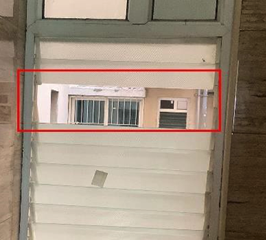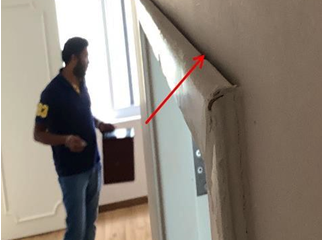A short overview of dampness by one of our Home Inspectors – Mohammed Hanifa. A 10 minute read.
Dampness is a state of excess or unwanted moisture which may be harmful in the context of walls/structure and may reduce its lifespan. The reasons for the same may be one or more of the below mentioned points:
- Abrupt breakage in the concealed plumbing lines.
- Seepage from the external drain outlet pipes/downspouts.
- Improper grouting in the bathroom tiles (flooring as well as wall claddings).
- Improper waterproofing on the external walls and roofs.
- An improper slope of the roof, causing water stagnation and moisture to appear on the ceiling.
Examples of Dampness:

Pic1: Paint peel offs

Pic2: Dampness on the external drain outlet

Pic3: Efflorescence on the wall

Pic4: Stains and patches on the wall

Pic5: Improper gradient

Pic6: Improper grouting in the tiles
Consequences of dampness:
- The moisture walls damage the woodworks (i.e., wardrobe, wooden flooring and wooden cabinetry etc. that may be in contact with walls).
- Paint peels off, patches and stains on the dampened wall affect the aesthetics of the building.
- Concealed rebars get corroded and start spalling in the wall.
- Concrete gets carbonated due to alkane present in the moisture and reduces the durability of the structure.
- Formation of fungus and growth of vegetation on the wall.
- Dampness cause efflorescence and deteriorates the wall.
- Accelerate the growth of termites and damages the woodworks.
- Provides an environment for mosquito breeding.
- It damages the flooring tiles/wooden flooring, since moisture in the floor weakens the adhesive beneath the tiles.
- Metal fixtures get corroded due to dampness.
Ways to address dampness:
The best way to address dampness is to find out the root cause and arrest it so that to prevent further deterioration. Following are few recommendations to address common causes of dampness:
- The breakage in the plumbing lines to be addressed; post rectification, the moisture wall/member to be dried out.
- The external drain outlet pipes/ downspouts to be checked and sealed properly so that it doesn’t leak through the joints.
- The grouting gaps in the bathrooms to be sealed properly using specified grout material.
- The cracks and deterioration on the roofs to be rectified using polymer fiber chemical or with an appropriate waterproofing compound, thereby to prevent leaking/dampness.
- The external walls to be painted or plastered with waterproofing chemical / compound to avoid dampness in the walls.
- The inadequate slope of the roofs to be addressed and rectify the slope so that water drains towards the drain outlet.
Remember – In Dampness, prevention is the cure!


